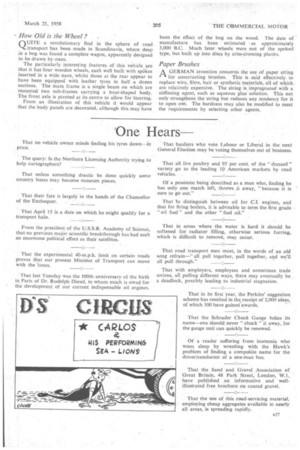Passing Comments
Page 30

Page 31

If you've noticed an error in this article please click here to report it so we can fix it.
G.M.C. Interest in Monorail
WHEN an organization such as the General Motors " Corporation of America takes an interest in the monorail system, it is to be expected that big developments are under way. At the Brussels Universal Exhibition, which opens on April 17, the Corporation will show a model of an elevated highway with an upper and a lower carriageway, each to convey traffic in a different direction, with a monorail suspended underneath.
The complete system is supported on stanchions of varying height according to the terrain, so that the carriageways and the monorail are level, notwithstanding the contours of the ground. It is thought that valuable land may be saved by elevated highways, and safety could be enhanced by automatic steering for vehicles.
This is achieved by means of a wire let into the road surface. The steering of vehicles is made sensitive to the magnetic field of the current passed along the wire.
Peep into the Future
THE Corporation's exhibit will be in the Transportation Pavilion and form part of an animated diorama depicting the world as it may look in the 21st century. The diorama will incorporate 500 electrical circuits, five miles of wiring, 29 electric motors and 14 hydraulic systems. The diorama was designed and partly built in Detroit and shipped to Belgium. It has 100,000 individual trees, 150 houses and hundreds of people, bridges, canal barges, animals and other items of scenery. Seven hundred model vehicles run along the roads at various speeds.
Filled With Treasure
nNE of the industry's most travelled men, Mr. John Oldham, chairman of Oldham and Son, Ltd.. has arrived back in England after a two-month visit to Africa, involving 23,000 miles of flying. His African workpeople presented him with a travelling case accompanied by the delightful hope that "you will travel the world with this case and bring it many times home filled with treasure." B26
Why Use Lugs?
'VHE advantages of Michelin X-type road-tread tyres for cross-country vehicles are pointed out decisively, in Tyre-Side Chats, published by the Michelin Tyre Co., Ltd. The conclusions reached after extensive tests carried out with Land-Rovers were that tyres with heavy lugs, ridges or knobs were by no means essential for use over wet or dry rutted, sandy mud with a gradient of 1 in 12; loose cinders and pebble tracks with a gradient up to 1 in 6; 8 in. to .10 in. of liquid mud over a comparatively firm sub-soil with gradients up to 1 in 5; boggy grassland with a gradient of 1 in 20; wet grassland with firm sub-soil and gradients of up to 1 in 5; and autumn-ploughed sandy, stony soil.
On soft ground, heavily patterned tyres were found to dig in deeply, causing big ruts. X tyres did not dig in al all and formed only shallow ruts. On steep gradients on which normal cross-country tyres caused wheelspin and severe damage to the surface, no damage to the surface occurred when using X tyres and the wheels did not dig in. When tried on wet grass, the lugged tyres could not be restrained from spinning and tore up the grass and soil, whilst the X tyres did not spin and caused no'damage.
For the short-wheelbase Land-Rovers, 6.00-16-in. X tyres can be used to replace the original 6.00-16-in. tyres, whilst on long-wheelbase models 6.50-16-in. X equipment can be substituted for the 7.00-16-in. tyres. In addition to the advantages shown by X tyres off the road, the Michelin engineers found that the tyres gave first-class riding and cornering characteristics on the road and that the steering was lighter than with the original tyres.
He Was Missed
A MONG those who were unable to be present at the E-1 convivial opening of the new teleprinter centre of British Road Services in London, last week, was Mr. Harold Elliott, chief traffic manager. He has been overworking and has had to take a long rest. The latest news is that he is recovering and his many old friends hope that he will soon be back at his desk.
How Old is the Wheel ? .
nUITE a revolutionary find in the sphere of road transport has been made in Scandinavia, where deep in a bog was found a complete wagon, apparently designed to be drawn by oxen.
The particularly interesting features of this vehicle are that it has four wooden wheels, each well built with spOkes inserted in a wide nave, whilst those at the rear appear to have been equipped with leather tyres in half a dozen sections. The main frame is a single beam on which are mounted two sub-frames carrying a boat-shaped body. The front axle is pivoted at its centre to allow for -Steering.
From an illustration of this vehicle it would appear that the body panels are decorated, although this may have been the effect of the bog on the wood. The date of manufacture has been estimated as approximately 3,000 B.C. Much later wheels were not of the spoked type, but built up into discs by criss-crossing planks.
Paper Brushes
AGERMAN invention concerns the use of paper string for constructing brushes. This is said effectively to replace wire, fibre, hair or synthetic materials, all of which are relatively expensive. The string is impregnated with a stiffening agent, such as aqueous glue solution. This not only strengthens the string but reduces any tendency for it to open out. The hardness may also be modified to meet the requirements by selecting other agents.








































































































